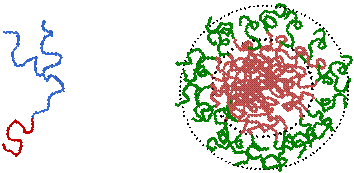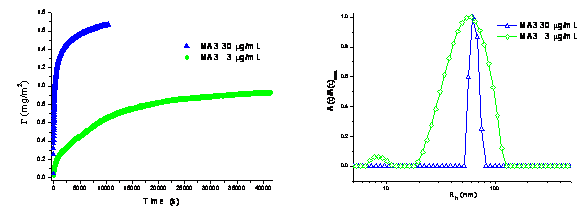Reports: AC7
47185-AC7 Structural and Frictional Interactions between Microphase Segregated, Multi-Component Polymer Brushes
Our PRF-sponsored research aims to examine the structure and interactions of self-organized, complex block copolymers, both when self-assembled into thin films at the solid-fluid interface, but also in solution, where they form micelles, vesicles, or nanoparticles. Copolymers consisting of two or more chemically dissimilar blocks share distinctive traits with small-molecule surfactants, perhaps most notably the ability to spontaneously organize into ensembles comprised of many single molecules. The size and shape of those supramolecular ensembles are determined by the composition, connectivity, and sequence of the constituent chains and the set of interactions those materials have with their solution environment. Polymeric micelles or vesicles are of practical importance for applications such as drug delivery or enhanced oil recovery, and those supramolecular ensembles also are of broad interest as building blocks in nanotechnology. Nevertheless, our understanding of the links between polymer architecture, self-assembled structure, and dynamics and interactions is quite limited.
To address this we are investigating the self-assembly of branched and multi-component block copolymers, focusing on how chain topology and interactions influences structure and surface properties, especially surface relaxations. We have used light scattering to determine the structure of self-organized, branched block copolymers in preferential solvents and a variety of surface sensitive techniques to examine kinetics of preferential adsorption and thin film morphology. Our investigations to date have involved three-arm mikto-arm (mixed arm) star-like copolymers consisting of polystyrene and polyisoprene and highly branched stars having arms consisting of poly(2-vinylpyridine-block-polystyrene) diblock copolymers, both of which are represented schematically in Figure 1. The former set of copolymers has been studied in n-hexane, which is preferential for polyisoprene and assembly and surface structure of the latter set has been examined in toluene, which is preferential for polystyrene.
Figure 1. Copolymers and architectures studied include mikto-arm (mixed arm) star-like copolymers (left) consisting of a branched polyisoprene block (blue) and a polystyrene end block (red); and highly branched star block copolymers (right) having polystyrene core blocks and poly(2-vinylpyridine) coronas (green).
Through these systems and complementary insights obtained through modeling we have demonstrated that the kinetics of assembly and surface relaxations are significantly impacted by polymer architecture. In cases where the assembly is conducted from a micellar solution, the kinetics of preferential adsorption depend strongly on surface relaxation/reorganization events, but they are also significantly impacted by the dynamic equilibrium that exists between single chains and supramolecular ensembles, as shown by the light scattering and phase modulated ellipsometry measurements presented in Figure 2. Next steps in the project involve examining nanoscale surface structure as well as structural response of surface tethered, multicomponent systems as solvent environment is changed. These systems are being made both by preferential adsorption of multicomponent block copolymers at the solid-fluid interface, but also by surface grafting, which involves reacting polymers onto solid substrates. The results emerging from our studies provide a basis for understanding how macromolecular architecture, especially branching and its impact on conformation induced confinement, and composition can be used to tune self-assembled structure and properties.
Figure 2. Results from phase modulated ellipsometry and dynamic light scattering showing how kinetics of preferential adsorption (left) and hydrodynamic size distribution of micellar aggregates (right), respectively, are affected by concentration of micelles in solution. These studies of the assembly and dynamics of self assembled miktoarm star-like copolymers reveal exchange of chains between free solution and the micellar structures that in turn impact relaxations and reorganization of the supramolecular ensembles at the solid-fluid interface.






